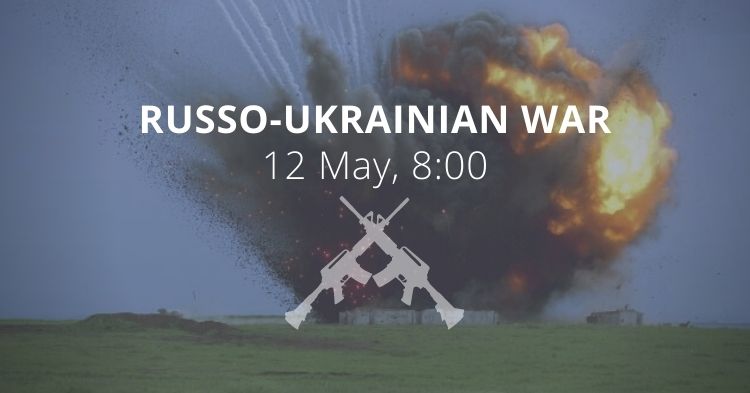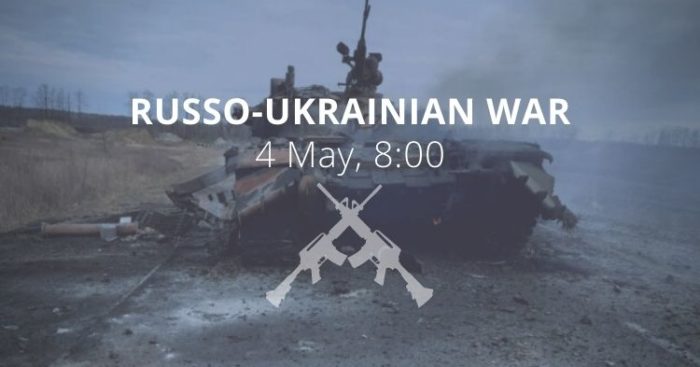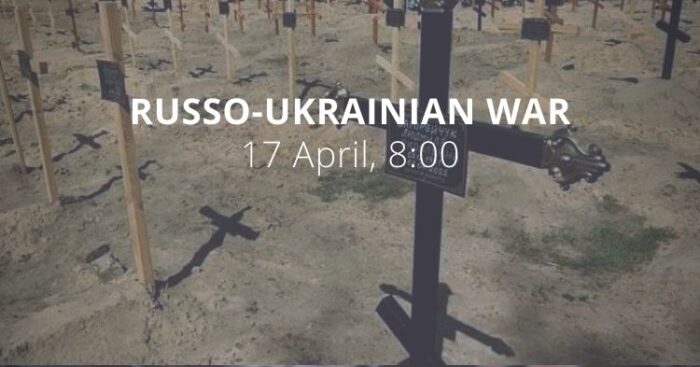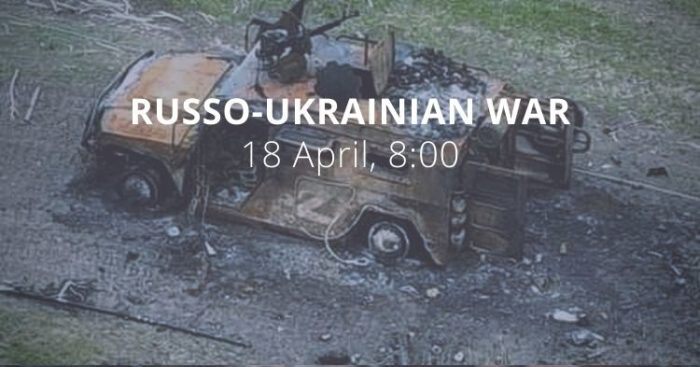Morning report day 78 – May 12
Situation
According to information from the General Staff:
Russian forces do not stop conducting offensive operations in the Eastern Operational Zone in order to establish full control over the territory of Donetsk, Luhansk, and Kherson oblasts and maintain the land corridor with the temporarily occupied Crimea.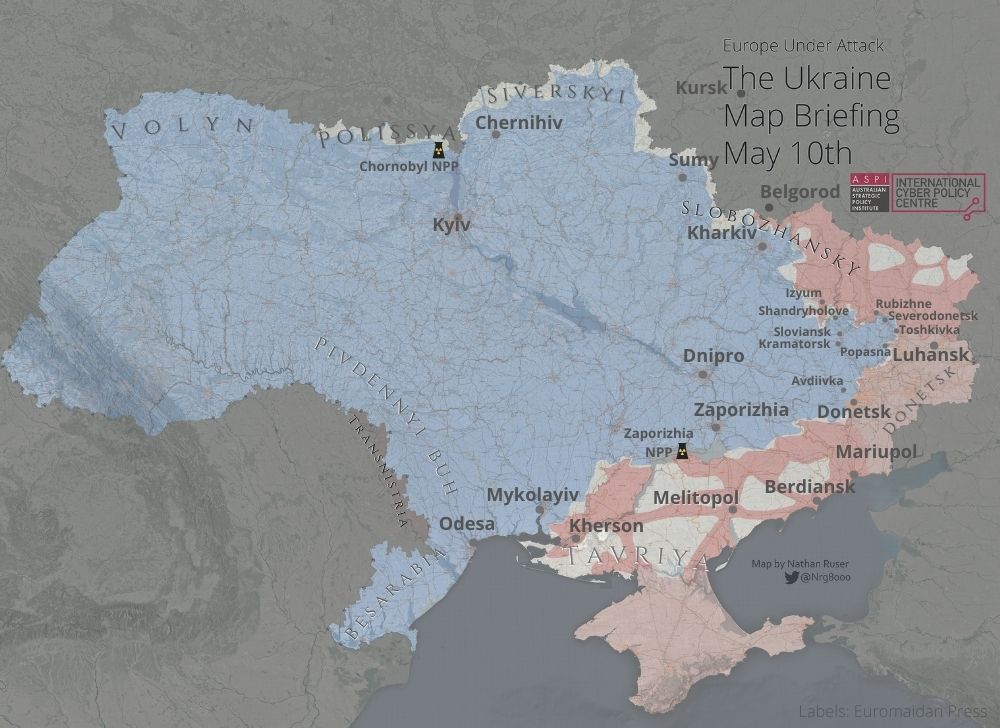
In the Volyn, Polissya, and Seversky directions, certain units of the Armed Forces of the Republic of Belarus continue to carry out tasks to strengthen the Ukrainian-Belarusian border in the Brest and Gomel oblasts. The threat of missile and bomb strikes on objects on the territory of our State from the territory of Belarus remains.
- At the checkpoints and in the border areas of the Bryansk and Kursk oblasts there are reinforced units of the FSS border service, as well as units of the armed forces of the Russian Federation. In addition, the Russian occupiers carried out artillery shelling of settlements in the Horodnyansky district of the Chernihiv oblast and launched an airstrike on the settlement in the Shostka district of the Sumy Oblast.
- In the Volyn and Polissya directions, Russian forces did not take active action. Measures of engineering equipment of defense positions along the state border in Brest and Gomel oblasts are underway. Meetings involving conscripts are being held in Brest and Grodno oblasts.
- The threat of missiles and airstrikes from the territory of the Republic of Belarus on the objects of Ukraine remains.
- In order to prevent the regrouping of our troops and their transfer to other areas, units of the Armed Forces of the Russian Federation continue to conduct demonstrations. In the oblasts bordering Ukraine, the enemy is increasing the air defense system.
In the Slobozhansky direction, Russian forces are regrouping troops to prevent the further advance of our troops in the direction of the state border of Ukraine. In the areas north of the city of Kharkiv, Russian forces fires artillery at units of our troops to inflict losses on manpower, weapons, and military equipment.
- In the Sloviansk direction, Russian occupiers are regrouping troops to resume the offensive on Barvinkove and Sloviansk. To strengthen the advanced units, the enemy moved the battalion tactical group.
- In order to replenish the units that suffered casualties and provide logistical support to the group of troops, Russian forces moved about 300 units of weapons and military equipment to the designated area.
- Russian forces did not carry out offensive operations in the Kharkiv direction. The occupying forces moved to the defense in order to slow down the pace of the offensive of our troops. In the course of successful actions of units of the Armed Forces of Ukraine, the settlement of Pytomnyk in the Kharkiv Oblast was liberated.
- In the vast majority of the temporarily occupied territories of the Kharkiv oblast, in order to prevent the transfer of information about the movement of Russian troops, the occupiers are suppressing the cellular network. Locals in many settlements remain without electricity and water. Entry into the territory controlled by Ukraine by the Russian occupiers is prohibited.
In the Donetsk direction, Russian forces units are trying to develop offensive operations in the Lyman, Sievierodonetsk, Bakhmut, Avdiivka, and Kurakhiv directions. The main task remains to establish full control over Rubizhne, and capture Lyman and Sievierodonetsk.
- In the Lyman direction, the enemy crossed the Siversky Donets River to enter the main forces and conduct an offensive. In the direction of Siversk leads the offensive in the direction of the Zelena Dolyna and Novoselivka. Fighting continues.
- Russian forces are trying to hold positions on the right bank of the Siversky Donets River.
- To ensure overcoming the water barrier, the aggressor transferred the equipment of the pontoon bridge from the territory of the Russian Federation in the direction of Kreminna.
- In the Sievierodonetsk direction, Russian forces are advancing in the direction of Kudryashivka, Sievierodonetsk, with partial success.
- In the Bakhmut direction, Russian forces are storming Pervomaisk and Komyshuvakha, and fighting continues.
- In the Bakhmut direction, in order to prepare for the offensive, Russian occupiers continue artillery shelling of the positions of our troops in the areas of the settlements of Svitlodarsk and Troyitske. Russian forces carried out assault operations in the directions of Orikhove and Toshkivka but were unsuccessful.
- In the Avdiivka direction, Russian forces are storming Novobakhmutivka and Novokalynove.
- In the Kurakhiv direction, Russian forces are advancing in the directions of Stepne – Novomykhailivka, Slavne – Novomykhailivka, and Oleksandrivka – Marinka. Fighting continues.
- In Mariupol, the main efforts of Russian occupiers are focused on blocking and trying to destroy our units in the area of the Azovstal plant. The enemy does not stop inflicting airstrikes.
- In the Zaporizhzhia direction, Russian forces fired at units of our troops with high-barreled artillery and rocket-propelled grenade launchers.
- Russian forces continue to fire on the positions of Ukrainian troops. Increased the intensity of air reconnaissance with the use of UAVs.
- In the territory of Donetsk and Luhansk oblasts, defenders of Ukraine repulsed nine enemy attacks and destroyed eight tanks, six units of armored combat vehicles, five cars and one enemy anti-aircraft gun.
In the Pivdenny Buh, and Tavriya directions, Russian forces are trying to improve their tactical position.
- In the Mykolayiv and Kryvyi Rih directions, Russian forces continue to fire artillery at the positions of our troops. In order to detect changes in the position of the Defense Forces, Russian forces conduct air reconnaissance, including the use of UAVs.
- Besides, in the Mykolayiv direction, around Nova Kakhovka the enemy carries out the preparation of engineering divisions for the guidance of pontoon-bridge crossings.
- In the Tavriya direction, Russian troops replenished their reserves and demonstrated to restrain the actions of our troops.
- The situation in the Bessarabian direction has not changed significantly.
- In the Black Sea and Sea of Azov zones, enemy naval groups perform the task of isolating combat areas and conducting surveillance. Russian occupiers are launching missile strikes on important infrastructure in Ukraine, providing support to ground forces in the coastal area and blocking civilian shipping.
Air defense units shot down four Orlan-10 UAVs.
The enemy suffers losses in other areas.
Russian forces continue to suffer losses. The enemy is disorganized and demoralized. According to available information, servicemen of certain units of the armed forces of the Russian Federation performing tasks on the territory of Ukraine were informed about the impossibility of rotating until the end of the so-called “special operation”.”
Planes, artillery, tanks, infantry: Russians storm Azovstal with everything they can, the Ukrainska Pravda reports citing the Azov Regiment.
“Over the past day, 38 aircraft flew to the territory of the Azovstal plant, which is defended by the defenders of Mariupol, including 4 sorties of strategic bombers. Also, enemy barrel artillery, tanks, and so on do not stop working. The Russian occupying forces do not stop trying to capture the Ukrainian fortress and continue to carry out daily assaults with the support of infantry.”
According to Ukrinform, Ukraine’s Deputy Prime Minister Iryna Vereshchuk has stated that
“As of now, it is impossible to unblock Azovstal by military means. Azovstal’s defenders do not want to surrender. It is worthy of respect. The Russians do not agree to an ‘extraction.’ This is a reality, but it is not surprising from the Russians”. She said that the government is working on different options and none of them is ideal.”
Surveillance video shows how Russian soldiers shot two unarmed civilians as they walked away after an encounter on the outskirts of Kyiv on March 16.
Both civilians died after being shot from the back.https://t.co/IOWjQAZuSS pic.twitter.com/vwaZKL03kd
— Euromaidan Press (@EuromaidanPress) May 12, 2022
Briefing on the security situation in Ukraine by Brigadier General Oleksiy Hromov, Deputy Chief of the Main Operations Department of the Ukrainian General Staff said at a press conference in Media Center Ukraine on May 11, 2022
Thus, we carried out crisis planning for the use of the Armed Forces of Ukraine together with other components of the Defense forces in advance. In addition, measures were taken to replenish troops with supplies of missiles, ammunition, logistics, and military equipment. Additional deployments in the form of exercises in threatening areas of new groups of troops, the involvement of relevant forces and means of the Armed Forces and other components of the Defense Forces in the defense of Kyiv, the creation of an appropriate command and control system. The forces and means of air defense were regrouped, as well as the relocation of our aircraft to field airfields was carried out in advance, a day before the beginning of the armed aggression.
Thanks to the measures taken and the mobilization of the Ukrainian people, we thwarted the enemy’s plans for a lightning blockade of Kyiv, the capture of Kharkiv, Mykolayiv, Odesa, Chernihiv, and Sumy. This forced the enemy to abandon their aggressive plans to focus on one direction.
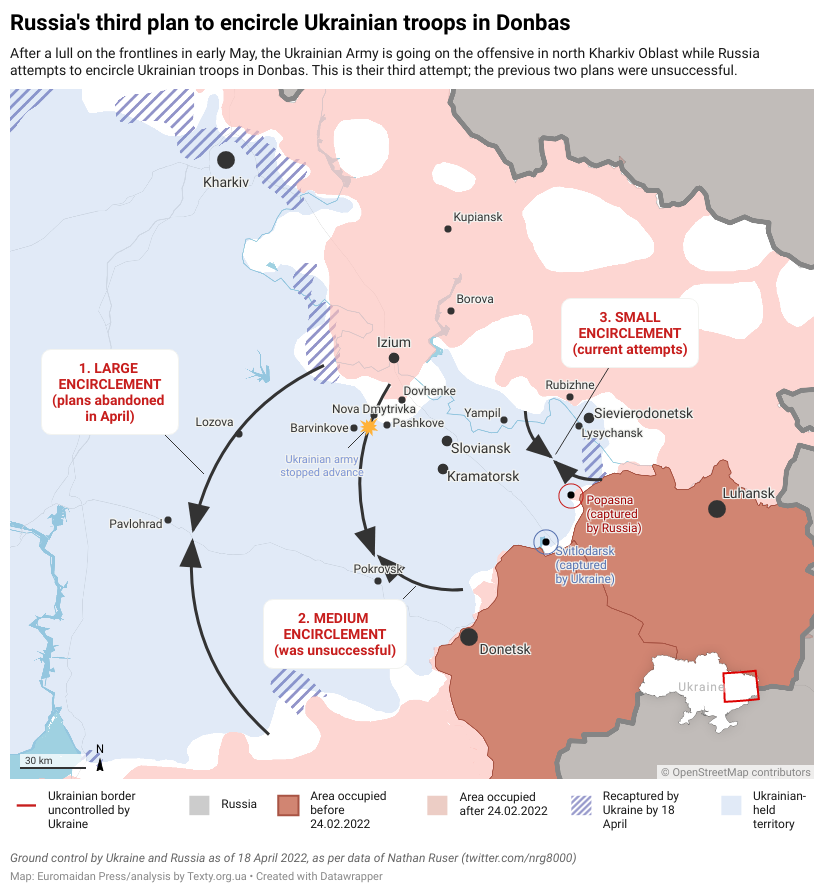
Currently, the most intense fighting is taking place in the Lyman direction in the Donetsk region.
In the area of Kharkiv, the enemy moved to the defense after an unsuccessful attempt to encircle the city. Having failed in the Izium direction, the enemy moved to the defense and is currently conducting deterrent actions, as well as transferring its forces to the Luhansk direction.
As a result of our active actions to liberate the occupied territories in the Kherson and Melitopol areas, the enemy has moved to the defense and is currently conducting deterrent actions.
The personnel of the Rear Admiral Mykhailo Bilynskyi 36th Separate Marine Brigade, 24th Separate Mechanized Brigade named after King Danylo, 92nd Separate Mechanized Brigade named after Ivan Sirko, 93rd Independent Kholodnyi Yar Mechanized Brigade of the Land Forces, 79th Separate Air Assault Brigade, 80th Separate Air Assault Brigade, 95th Separate Air Assault Brigade of the Air Assault Troops of the Armed Forces of Ukraine, as well as other military units of the Armed Forces of Ukraine with the support of Territorial Defense brigades heroically showed themselves in fierce battles.
Currently, the fire on the positions of our troops with the use of enemy aircraft, mortars, artillery, and MLRS does not stop. First of all, this applies to the Sievierodonetsk, Popasna, and Kurakhiv directions.
The blockade and fire on our units in the area of the Azovstal metallurgical plant in Mariupol continues. The connection with the units of the defense forces, which heroically hold their positions, is stable and maintained. Today, the deblocking operation will require the involvement of a significant number of troops, as units of the Armed Forces of Ukraine are located 150-200 kilometers from Mariupol. The enemy also created an extensive system of engineering barriers and defensive lines, which will lead to significant losses from our troops.
I would like to emphasize that the planning and conduct of any operations is not a topic for public discussion. The Armed Forces of Ukraine have repeatedly delivered ammunition, communications, and medicine to Mariupol. Such deliveries were possible until the information about the aid was disseminated. As a result, the enemy took measures to strengthen the air defense system, which made it difficult for us to carry out such actions and led to the loss of personnel and helicopters that evacuated the wounded.
Currently, the enemy, using the tactics of the so-called creeping offensive in eastern Ukraine with the support of artillery and aircraft, is trying to surround and defeat the Joint Forces. At the same time, we are succeeding in the Kharkiv direction, where we are gradually displacing the enemy and liberating our settlements.”
On February 24, the Russian Federation launched a new phase of the war against Ukraine – a full-scale invasion. Russian invaders shell and bomb peaceful towns and villages in Ukraine, and torture and kill civilians. Ukraine’s defense forces are fiercely resisting the Russian invaders and inflicting heavy losses on them.
The threat of the enemy’s naval landing operation in the Black Sea operational zone remains. “Warships and submarines continue to be stationed in the waters of the Azov and Black Seas, supporting ground forces operating along the coast, as well as launching high-precision weapons at facilities deep in Ukraine.
The enemy does not stop inflicting air and missile strikes at sea and air bases, including with the use of long-range aircraft on military and critical infrastructure and industrial facilities, transport networks – recently, especially on railway facilities, trying to disrupt the expansion of support and logistics of our groups operating in the east of Ukraine.
The losses of the enemy at present from the beginning of the so-called “special operations” already make up about 20% of personnel and up to 60% of the main types of weapons and military equipment.
But even the achievement by the enemy of the declared goal of the second stage of the so-called “special operation” – the occupation of Donetsk and Luhansk oblasts within their administrative borders, most likely, will not satisfy its ambitions, but only create conditions for the expansion of aggression.”
On May 11 Ukrainian Armed Forces (UAF) have:
- Killed 250 invaders and destroyed 6 tanks, 1 infantry fighting vehicle, 2 armored personnel carriers, and 2 armored fighting vehicles. in the Eastern Operational Area (Kharkiv, Donetsk, Luhansk, Dnipropetrovsk, and Zaporizhzhia Oblasts). presumably outside the JFO area.
- destroyed 8 hostile tanks, 6 armored fighting vehicles, 5 motor vehicles, and 1 anti-aircraft gun in the Joint Forces Operations (JFO) Area (Luhansk and Donetsk).
- Killed 23 invaders, and destroyed 2 enemy tanks, 2 infantry fighting vehicles, and an ammunition depot (Kherson Oblast) in the Southern Operational Area (Vinnytsia, Kirovograd, Odesa, Mykolaiv and Kherson Oblast).
According to British Defense Intelligence, (last 24 hours):
- Ukrainian forces are continuing to counter-attack to the north of Kharkiv, recapturing several towns and villages towards the Russian border. Russia’s prioritization of operations in the Donbas has left elements deployed in the Kharkiv Oblast vulnerable to the mobile, and highly motivated, Ukrainian counter-attacking force.
- Despite Russia’s success in encircling Kharkiv in the initial stages of the conflict, it has reportedly withdrawn units from the region to reorganize and replenish its forces following heavy losses. Once reconstituted, these forces will likely deploy to the eastern bank of the Siverskyi Donets River, forming a blocking force to protect the western flank of Russia’s main force concentration and main supply routes for operations in the vicinity of Izium.
- The withdrawal of Russian forces from the Kharkiv Oblast is a tacit recognition of Russia’s inability to capture key Ukrainian cities where they expected limited resistance from the population.
As of Thursday 12 May, the approximate losses of weapons and military equipment of the Russian Armed Forces from the beginning of the war to the present day: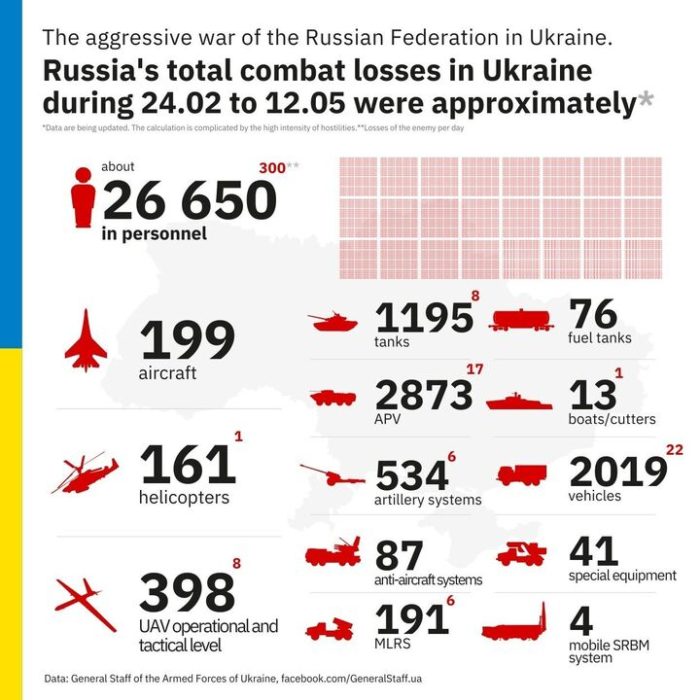
- Personnel – more than 26650 people (+300),
- Tanks – 1195 units (+8),
- Armored combat vehicles – 2873 units (+17),
- Artillery systems – 534 (+6),
- Multiple rocket launchers – 191 (+6)
- Air defense means – 87 (+0),
- Aircraft – 199 (+0),
- Helicopters – 161 (+1),
- Automotive technology and fuel tanks – 2019 (+22),
- Vessels/boats – 13 units (+1),
- UAV operational and tactical level – 398 (+8)
- Special equipment – 41 (+0)
- Mobile SRBM system – 4 (+0)
- Cruise missiles – 94 (+0)
Russian enemy suffered the greatest losses (of the last day) in the Kurakhiv direction.
National Guard announces its losses caused by the war, the Ukrainska Pravda reports. “Unfortunately, in the course of performing their tasks during this period, of the National Guards, 1,697 were wounded and 501 killed,” the Head of the Operational Department of the headquarters of the Main Directorate of NGU, Oleksiy Nadtochy, said.
Humanitarian
Ukraine is suggesting exchanging severely injured defenders of Azovstal for the Russian prisoners of war, according to the Deputy Prime Minister and Minister of Reintegration of Temporarily Occupied Territories of Ukraine.
“As of now, there is no chance to unblock Azovstal by military means. Azovstal defenders do not want to surrender. This is worthy of respect. Russians do not agree on “extraction”. This is the reality, but Russians do not surprise us anymore. Right now, the Government works out different scenarios. We are looking for an effective, not ideal one. Negotiations are still on.”
27-year-old American citizen Kirillo Alexandrov and his Ukrainian wife &mother-in-law were held captive by Russians for alleged espionage.They were released
"I was cuffed and beaten a few times. My wife was assaulted. We are victims of war crimes,"he said https://t.co/QAWHDGZyo2 pic.twitter.com/qgsQuZQdQx
— Euromaidan Press (@EuromaidanPress) May 12, 2022
Occupiers block Ukraine’s gas supply to Luhansk and Donetsk oblasts, the Ukrainska Pravda reports.
“The Russian occupiers have blocked the taps of the Shebelinka-Novopskov main gas pipeline without authorization, leaving the residents of the Luhansk and Donetsk oblasts without a Ukrainian gas supply. This was announced by the head of the gas transportation system of Ukraine Serhiy Makogon”.
According to UNHCR 5,981,358 refugees have been registered as of May 10. The UN says that so far Poland has taken in 3,251,955 refugees, Romania 889,674, Russian Federation 772,121, Hungary 577,820, Republic of Moldova 458,242, Slovakia 406,833 and Belarus 27,108. Among those who fled Ukraine are also Ukrainian nationals with dual citizenship. An additional 105,000 people moved to the Russian Federation from the Donetsk and Luhansk oblasts between 18 and 23 February.
The number of Ukrainians entering Ukraine since February 28 is 1,590,500 as of May 10. This figure reflects cross-border movements, which can be pendular, and does not necessarily indicate sustainable returns.
OHCHR recorded 7,256 civilian casualties in Ukraine as of May 10. 3,491 were killed (including 238 children) and 3,760 injured (including 348 children).
World impact
Direct damage caused to Ukraine’s infrastructure during the war has reached over $94 billion, Kyiv School of Economics reports. Total economic losses since the beginning of the war are estimated at $564-600 billion or above
This can be seen from the analysis carried out within the “Russia will pay” project by the KSE Institute team (the analytical unit of Kyiv School of Economics) with the support of the Presidential Office, the Ministry of Economy, the Ministry of Reintegration of Temporarily Occupied Territories and the Ministry of Infrastructure. The project team also includes volunteers from the Center for Economic Strategy, Dragon Capital, the Anti-Corruption Headquarters, Institute of Analysis and Advocacy, Transparency International Ukraine, Prozorro.Sale, Prozorro, and Ukrainian Council of Shopping Centers.
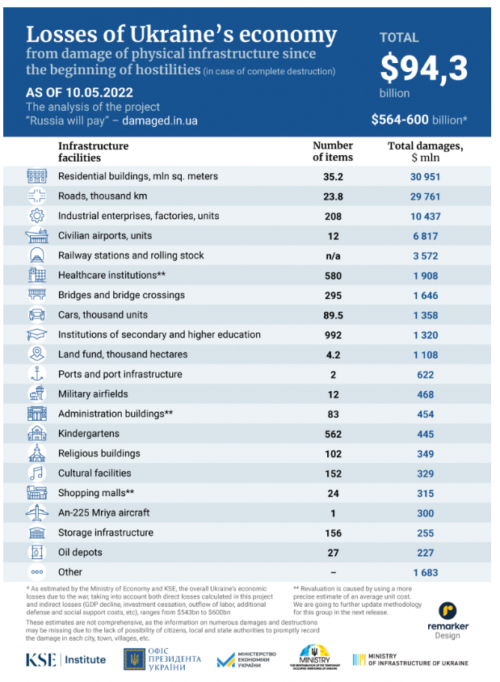
In the current calculations, KSE’s estimate of losses from destruction and damage to oil depots has been added. As of May 10, the losses from the destruction of 27 oil depots amount to $227 million. In addition, according to the latest estimates within the project “Russia will pay” the total number of destroyed or damaged educational institutions is almost one thousand, and losses reach $1.3 billion.
Since the beginning of Russia’s war against Ukraine, at least 208 factories and enterprises, 508 healthcare institutions, 562 kindergartens, 156 warehouses, 992 educational institutions, 295 bridges and bridge crossings, 102 religious buildings, 83 administrative buildings, 27 oil depots, and 12 civilian airports and have been damaged, destroyed or seized.
As estimated by the Ministry of Economy and KSE, overall Ukraine’s economic losses due to the war, taking into account both direct losses calculated in this project and indirect losses (GDP decline, investment cessation, an outflow of labor, additional defense and social support costs, etc), range from $564 billion to $600 billion.”
Legal
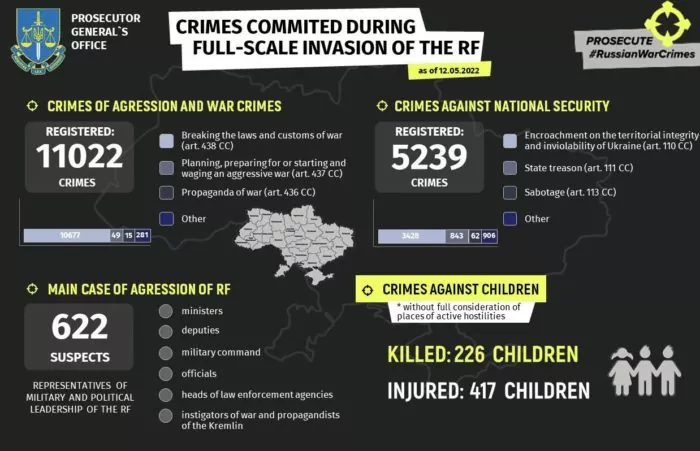
226 children were killed, and 417 children injured, the Office of the Prosecutor General of Ukraine reports as of May 12. 1,721 educational establishments are damaged as a result of shelling and bombings, 139 of which are destroyed fully. 11,022 crimes of aggression and war crimes and 5,239 crimes against national security were registered.
https://twitter.com/EuromaidanPress/status/1524600251201380355?s=20&t=jUHD0r768y_rw40EHWtpMg
Support
The United States pledges to help rebuild Ukraine, the Ukrinform reports.
“U.S. efforts are currently focused on ending the war in Ukraine, but Washington is ready to provide assistance to rebuild Ukraine. Of course, the first order of business is bringing this – Russia’s aggression to a close. We’re focused on that, Ned Price, Spokesperson for the US Department of State, said at a briefing on May 11.
According to him, the US is currently focused on providing economic, humanitarian, and security support to Ukraine. But when there is an opportunity to help rebuild Ukraine to emerge from the destruction that the Kremlin has wrought across parts of the country, the United States will be there for that as well, Price stressed.”
Top EU official backs multi-trillion plan to rebuild Ukraine, the Reuters reports. A top European official has backed a multi-trillion-euro “Marshall”-style plan to rebuild Ukraine, pledging the firepower of the EU’s lending arm for what he said must be a global rescue effort.
Werner Hoyer, president of the European Investment Bank (EIB), said Europe must not be left alone to foot the vast bill from Russia’s invasion of Ukraine that he predicted could run into the trillions.
Under the Marshall Plan implemented after World War Two, the United States granted Europe the present-day equivalent of some $200 billion over four years in economic and technical help.
Addressing the need for a similar program for Ukraine, Hoyer told Reuters the cost of rebuilding the country had been discussed at recent meetings at the United Nations, the International Monetary Fund, and World Bank in Washington.
“What will it cost to rebuild, reconstruct Ukraine? Figures were flying around the room … but one thing is quite clear to me: We are not talking about millions but trillions” said Hoyer, a former German foreign office minister under Chancellor Helmut Kohl following the fall of the Berlin Wall.
Hoyer’s remarks underscore how the European Union is preparing to tackle the ever-growing economic impact of the war, using the clout of the pan-national EIB, which typically funds roads, bridges and other infrastructure.
“It’s a challenge for the entire free world to make sure that this (support) will be provided,” said Hoyer. “The political leaders must make up their mind as soon as possible,” Hoyer said. “But I think we need a structure that is really targeting a global audience and not just the taxpayers in the European Union.”
New developments
1. Putin official says Kherson Oblast should enter Russian Federation “as legitimately as Crimea“, the Ukrainska Pravda reports. The so-called “authorities” of the Kherson Military-Civilian Administration, appointed by the occupiers, have announced that they will ask Russian President Vladimir Putin to include Kherson Oblast in the Russian Federation. According to RIA Novosti, Kremlin Press Secretary Dmitry Peskov has said that the annexation of the occupied Kherson Oblast should take place “legitimately, as it was with Crimea”.
2. Zelenskyy: We will liberate our land and our people, the Ukrinform reports. Ukrainian land and Ukrainian people will be liberated from Russian invaders, and it will be easier to do so with the help of the entire free world.
3. War will end when Ukraine gets everything back, says Zelenskyy, the Ukrinform reports.
“President Volodymyr Zelenskyy has stated that the war with Russia will end when Ukraine regains its territories, people, peace, freedom, and choice. “Russia gradually took away, occupied all our rights: the right to our land, the right to choose, and eventually the right to live,” said the president, adding that now “we are fighting for our lives and losing our lives.”
Volodymyr Zelenskyy stressed the importance of Russia’s presence at the negotiating table and, in his words, “understanding the inevitability of punishment and the great fallibility of their steps, which will and have already led to a catastrophic future of their (Russian – ed.) culture, consciousness, and state, but it was their decision.” He explained that this should be a dialogue, not an ultimatum.”
4. The UK strikes a new security agreement with Sweden and Finland, the Reuters reports.
“British Prime Minister Boris Johnson on Wednesday said he had agreed on new deals with Sweden and Finland to bolster European security, pledging to support both countries’ armed forces should they come under attack. Johnson signed the new declarations, described by Britain as “a step-change in defense and security cooperation”, during visits to both Sweden and Finland on Wednesday”.
5. Finland president to green-light NATO entry, the Reuters claims.
“President Sauli Niinisto is expected to give a green light on Thursday for Finland to join the NATO military alliance, in a major shift of security policy in the wake of Russia’s invasion of Ukraine. Finland, which shares a 1,300 km (810 mile) border and a difficult past with Russia, has gradually stepped up its cooperation with the North Atlantic Treaty Organization as a partner since Russia annexed Crimea in 2014.
“My message is clear: Finland will ensure its security. That is not to anyone’s detriment,” Niinisto said last week after meeting with the parliament’s defense committee.”
6. Bank of Russia identifies the main risks for its baseline scenario, the TASS reports.
“Among the main risks, the regulator pointed to further strengthening of external trade and financial restrictions, a more significant decline in the potential of the Russian economy than was expected in the baseline scenario, as well as an increase in inflation expectations. The uncertainty of the baseline scenario presented earlier by the Bank of Russia remains extremely high, the regulator believes. Thus, the scenario significantly depends on the development of geopolitical factors, as well as on the ability of the economy to adapt to new conditions, the Bank of Russia said.”
Assessment
On the War
The Institute for the Study of War has made the following assessment as of Wednesday 11 May:
Russian forces fired at Ukrainian positions around Izium but did not make any confirmed advances on May 11. …Pro-Russian media outlet Readkova noted that Ukrainian forces are attempting to cross the Severskyi Donets River by Chepil (about 40 kilometers northwest of Izium) to cut off Russian ground supply lines to Izium, although ISW cannot independently confirm this claim.
Russian forces continued ground offensives westward in Donetsk and Luhansk Oblasts on May 11. Russian troops continued attempts to encircle the Rubizhne-Sievierodonetsk-Lysychansk area and Ukrainian sources reported intense fighting in Sievierodonetsk, Lysychansk, Rubizhne, Bilohorivka, Vojevodivka, Nyzhnie, Toshkivka, and Orikhove. Russian forces are also likely preparing for a new line of advance towards Bakhmut, about 50 kilometers southeast of Sloviansk, along the M03 highway. … The move towards Bakhmut is likely intended to gain access to the M03 highway and continue the northwestward push towards Sloviansk. Russian forces continued unsuccessful ground assaults around Donetsk City, as they have for the last several days.
Russian forces continued to conduct ground attacks against Ukrainian positions in the Azovstal Steel Plant with the support of air and artillery strikes on May 11. … Advisor to the Mayor of Mariupol Petro Andryushchenko claimed that Russian authorities are deporting those who are deemed to be “suspicious” during filtration measures in Mariupol to a detention camp in Olenivka, Donetsk Oblast. Andryushchenko compared the facility to a concentration camp and stated that detainees are subject to overcrowding, atrocious conditions, mass interrogations, and forced disappearances. ISW cannot independently confirm these claims, but they are fully in line with previously reported Russian ”filtration” measures in occupied Ukraine.
Russian forces moved to the defensive in order to prevent further advances north to the Russian border by the ongoing Ukrainian counteroffensive around Kharkiv City on May 11. Pro-Russian media outlet Readkova reported that Ukrainian forces are preparing for an offensive in Kozacha Lopan and Tsupivka, both within 10 kilometers of the international border, confirming reports from May 10 that Ukrainian forces had advanced to within 10 kilometers of the Russian border.
Russian forces continued to shell Ukrainian positions along the Southern Axis but did not make any confirmed advances on May 11. The Ukrainian General Staff reported that Russian forces are attempting to take control of Bruskynske and Velyka Oleksandrivka to improve their tactical position in the South.19 These settlements lie within 15 kilometers of the Kherson-Mykolaiv border and would likely allow Russian troops to conduct offensive actions towards Mykolaiv. The UK Ministry of Defense stated that Russian troops are likely trying to reinforce their garrison on Zmiinyi (Snake) Island … for increased access to the northwestern Black Sea. The situation in Transnistria remains tense but unchanged.
Key Takeaways
- The Ukrainian counteroffensive north of Kharkiv City has forced Russian troops onto the defensive and has successfully alleviated artillery pressure on Kharkiv City.
- Russian forces continued efforts to encircle Ukrainian positions in the Sievierodonetsk-Rubizhne-Lysychansk area but did not make any confirmed advances.
- Russian forces may be initiating a new advance towards Bakhmut after capturing Popasna in order to secure highway access north to Sloviansk.
- Russian forces are attempting to consolidate their positions in western Kherson Oblast to push into Mykolaiv Oblast.
- Pro-Russian Telegram sources reported Ukrainian forces may be conducting a counterattack 40km north of Izium to cut off Russian units in this key town, though ISW cannot confirm these reports at this time.“
Consequences and what to do?
Putin does not want to take on NATO – Pentagon chief, the Reuters reports.
“The United States does not believe that Russian President Vladimir Putin wants to militarily take on the NATO alliance, US Defense Secretary Lloyd Austin said on Wednesday, as Moscow struggles to achieve its goals in Ukraine three months into its invasion.
“As you look at Putin’s calculus, my view – and I’m sure the chairman has his own view – but my view is that Russia doesn’t want to take on the NATO alliance,” Austin said during a congressional hearing.”
Assessment by Hans Petter Midttun
Ukraine has until recently, been on the defensive since 2014. The counter-offensive in the Kharkiv oblast is, therefore, highly welcome news. The overall indications of Ukraine having stalled the Russian advance elsewhere help bring hope into the equation. The sense of success is also supported by the reports on Russian casualties and loss of material, Ukrainian successful attacks on Zmiinyi (Snake) Island, international resolve and unity, the inflow of defense aid, and not least, reports on the tremendous courage and resistance demonstrated by the Ukrainian Security and Defense Sector.
The claims that the war has reached a stalemate are, however, false. The observations and assessments are based on the situation on the ground. The abovementioned assessments do not take into consideration the situation in the Sea of Azov of the Black Sea where Russia has already achieved full control, and there are no attempts to challenge its Sea Control and Maritime blockade of Ukraine. Ukraine is, therefore, still “bleeding” as its economic foundation has been effectively undermined.
In the report “Ukrainian storm warning” by the Centre for Defense Strategies, I outlined the “Maritime Ripple Effects” resulting from an embargo/blockade.
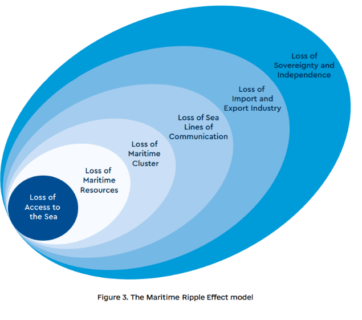
If (or when) Russia decides to impose a full blockade of all Ukrainian ports, the Ukrainian economy will collapse. The loss of access to the sea will stop all maritime imports and exports. This will result in the loss of jobs and income, affecting all other parts of the Ukrainian business environment. The loss of freedom of navigation and SLOCs will severely damage a number of industries and severely affect the lives of millions of Ukrainians.
Ukraine lacks the capabilities needed to do both, while the international community has the capabilities, but lacks the will to employ them.
A huge misconception has been established in the mind of Western policy and decision-makers, and populations. The idea that a NATO engagement in Ukraine will trigger WW3 and the use of nuclear arms has been established as an “eternal truth”.
I have previously argued that we are already a part of a much broader conflict. I presented the assessment from the European Parliament on 16 September last year. The many Russian belligerent actions against both Ukraine and the West during the last 8 years have been listed. The USA, NATO and the EU have acknowledged that European security is threatened as a consequence of Russia’s invasion of Ukraine. The Russian Federation itself has stated that the Motherland is being threatened by Ukraine, the USA, and NATO, stressing that we are waging war against Russia.
I have also highlighted the Hybrid War and its effect on conflict resolution and the will to engage militarily. The main battlespace of the hybrid war occurs inside the cognitive spaces of populations and key decision- and policymakers. The strategy exploits the protest potential of the population of both the nation under assault and that of its partner nations. It manipulates and reinforces existing vulnerabilities trying to ignite social instability. It aims to destabilize and undermine alliances, partnerships, and nations from within through disinformation. It allows Russia to undermine nations’ legitimacy, credibility, and moral and ethical standpoints, thereby reducing trust and international support.
These are not only words but real tangible effects.
During the Cold War, a NATO consisting of 16 member states was prepared to fight the Warzaw Pact if challenged. Today, a NATO with 30 member states is reluctant to take on only Russia (even as it is stumbling in Ukraine). Has someone been playing with our heads for the last two decades?
The counterargument would be that NATO would fight if any members of the Alliance were attacked. That’s why western leaders continuously stress that “Ukraine is not a NATO member” not eligible for the collective defense offered to member states. “Collective defense means that an attack against one Ally is considered as an attack against all Allies. The principle of collective defense is enshrined in Article 5 of the Washington Treaty.”
Collective defense is also laid down in the NATOs strategic concept as one of its three essential core tasks in its Strategic Concept. “The modern security environment contains a broad and evolving set of challenges to the security of NATO’s territory and populations. In order to assure their security, the Alliance must and will continue fulfilling effectively three essential core tasks, all of which contribute to safeguarding Alliance members, and always in accordance with international law: (1) Collective defense – (2) Crisis management – (3) Cooperative security.
While the measures taken to strengthen the security of NATO’s eastern member states since 2014 as a response to the Russian war against Ukraine falls under crisis management, it does not meet the objective of the strategic concept. According to the concept NATO is obliged “to stop ongoing conflicts where they affect Alliance security, and to help consolidate stability in post-conflict situations where that contributes to Euro-Atlantic security.”
I have argued that if NATO chose not to meet its obligations under the strategic concept by not engaging in Crisis Management, it jeopardizes the credibility of it fulfilling the two other essential core tasks, of which one is Collective Defense.
This brings me back to the issue of the battlespace of the hybrid war which occurs inside the cognitive spaces of populations and key decision- and policymakers. Ignoring the fact that Russia already sees the Alliance as a party to the war, the concern seems to be centered on the notion that NATO “boots on the ground” will trigger a WW3 and the use of nuclear arms.
Russia’s main concern is presently one thing, and one thing only: Do it win or not? It does not matter if it is defeated by Ukraine (being supported by Western sanctions, defense aid, humanitarian aid, and economic support) or a combined Ukrainian and NATO military efforts. A defeat in whatever form or shape means the end to its global ambitions.
If we are truly concerned that a Russian defeat might trigger WW3, we should stop supporting Ukraine and remove all sanctions on Russia. But we are not, and we should not. On the contrary, we should ramp up our support to make sure Ukraine win.
Ukraine failed to deter Russia. NATO does not. “The United States does not believe that Russian President Vladimir Putin wants to militarily take on the NATO alliance”, US Defense Secretary Lloyd Austin said on Wednesday, as Moscow struggles to achieve its goals in Ukraine three months into its invasion.
The war has not reached a stalemate because the maritime blockade is still undermining Ukrainian independence and sovereignty.


